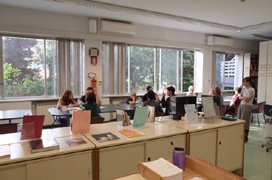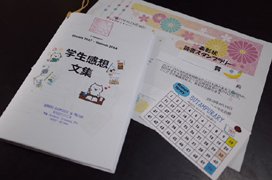Creating Diverse Opportunities to Learn
The Japan Cultural Institute in Rome
TSURUTA Yasuyuki
The Japan Foundation’s Japan Cultural Institute in Rome (hereinafter “the Institute”) was opened in 1962 as the first institute for Japanese culture created overseas by the Japanese government. The Institute’s Japanese-language course was started two years later in 1964, meaning that today it boasts a history of more than 50 years as a Japanese language course for the general public. A wide range of age groups are represented among the students, from teens to 80s, and their backgrounds, lifestyles, and purpose and goals for learning Japanese, vary widely as well. The Institute provides a course conforming to the JF Standard for Japanese-Language Education that meets the diverse needs of the students while teaching them through a focus on task execution ability and intercultural understanding.
Meanwhile, there have been major changes in the way languages are learned due to the development of the Internet. Specifically, an environment is emerging that allows learners to study Japanese on their own without the teachers or classrooms previously assumed to be a requirement. Accordingly, the Institute provides support for autonomous learning in parallel with the operation of the Japanese-language course.
Japanese-Language Course
The Institute offers three courses, called the Comprehensive Course, the Evening Course, and the Saturday Course, that each follow the Japan Foundation’s “Marugoto: Japanese Language and Culture” (hereinafter “Marugoto”) to teach each student according to their lifestyle and goals.
The Comprehensive Course takes place in the evenings and is aimed towards students who wish to take the time to learn Japanese properly. The course consists of two classes per week of three hours each for a total of two years, or 336 hours to learn up to the pre-intermediate level (“Marugoto Pre-Intermediate”). An additional one year Comprehensive class will be launched from October 2018 using “Marugoto Intermediate.”
Next, the evening course is attended by many university students and working adults who have some time to study Japanese. Classes are held twice per week for two hours each class for a total of 336 hours over three years, covering the elementary and pre-intermediate levels (halfway through “Marugoto Pre-Intermediate”).
Finally, the Saturday Course is attended by many who wish to study Japanese at an easier pace or as a hobby. The two hour classes are held every Saturday, and students study the starter to elementary levels (“Marugoto Elementary 1”) for a total of 168 hours over three years.
These courses are offered in half year to one year increments, but there are also special short-term courses geared towards specific hobbies and interests. For example, popular courses held in AY2017 include “Japanese for Travel,” “Japanese for Shodo (calligraphy),” and “Japanese for Karuta (cards).”
Accordingly, the Institute is committed to hosting a variety of courses to match the lifestyles, learning goals, and interests of those who want to learn or interact with Japanese.
Autonomy Support Course
The Institute launched an autonomous learning support course in October 2017 as part of our initiative to support autonomous learning. The purpose of the course is to enable the students to build a habit of self-study, either alone or in cooperation with other students, to eventually be able to learn entirely on their own using online resources and other teaching materials. The course is held in the Institute’s library twice per week, and those who wish to attend are required to submit a learning plan before attending containing the content of the day’s studies and Can-do goals (what they hope to achieve through the studies).
Then on the day of course, each student studies according to their plan. A teacher attends the sessions in the library, but does not teach any lessons. Instead, they provide assistance and advice according to the needs of the student in achieving their plan. Some of the repeat students are already taking an approach unlike the standard Japanese-language course, such as writing reports on a variety of themes together with their friends, or writing short essays using the Kanji characters they learned that day.
Tadoku Reading Activity and the Reading Stamp Rally
Finally, the Institute carries out two more important activities: the Tadoku reading activity and the reading stamp rally. These activities, carried in cooperation with the Institute library, aim to increase the number of opportunities for students of the Japanese-language courses to interact with Japanese outside of textbooks and to promote greater use of the library. Italian learners have a strong tendency to try to translate the meaning of the Japanese into Italian and want to know meaning of words in Italian. This means they are less able to use predictive logic while reading text. In response, the Tadoku reading activity attempts to demonstrate the enjoyment that can be had by reading Japanese without dictionaries or teachers. The activity uses teaching materials for Tadoku (literally “read a lot”) with carefully designed vocabulary. Students spend the first half of the activity reading several booklets on their own. Then in the second half, they discuss their opinions on the booklets with each other. According to a questionnaire given to participants, many commented that they were able to enjoy reading without feeling so uncomfortable even when there were words they did not understand, and that they hope to use the Tadoku reading approach to read full books. In the future, we plan to open the activity up to participants from outside the Japanese-language courses as well.

A Tadoku reading activity

Book reports, stamp cards, and awards from the Reading Stamp Rally
The Reading Stamp Rally is an activity where students read books in the collection of the library and write a brief report on each. Students are given handmade awards and commemorative gifts according to how many reviews they write. Furthermore, in order to connect the private activity of book reading with the world at large, the reports written by the students are compiled into a collection to be made freely available for students of the Japanese-language courses to view.
Moving forward, the Institute will continue to value its role as a classroom for diverse people to gather and learn together while continuing to support autonomous learning as a way to study without necessarily relying on teachers and classrooms.
- What We Do Top
- Arts and Cultural Exchange [Culture]
- Japanese-Language Education Overseas [Language]
- Japanese-Language Education Overseas [Language] Top
- Learn Japanese-language
- Teach Japanese-language
- Take Japanese-Language Test
- Know about Japanese-language education abroad
- The Japanese-Language Institute, Urawa
- The Japanese-Language Institute, Kansai
- Japanese-Language Programs for Foreign Specified Skilled Worker Candidates
- Japanese Language Education for Japanese Children Resident Overseas and for the Descendants of Migrants
- Archives
- Japanese Studies and Global Partnerships [Dialogue]
- JF digital collection
- Other Programs / Programs to Commemorate Exchange Year
- Awards and Prizes
- Publications
